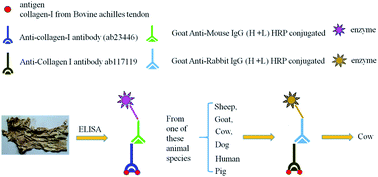Species identification of ancient leather objects by the use of the enzyme-linked immunosorbent assay
Abstract
Leather is one of the indispensable necessities in human daily life. However, the identification of ancient leather, especially species identification, is a great challenge for archaeologists and conservation scientists. Fortunately, the non-competitive indirect enzyme-linked immunosorbent assay (ELISA) offers a particularly promising approach for the analysis of ancient leather because of its advantageous properties such as high efficiency, low-cost, and high sensitivity and specificity. This study focuses on the use of a non-competitive indirect ELISA method to identify the species of ancient leather. Three ancient leather samples, which were unearthed from the desert in the Xinjiang area, were characterized using an analytical Oxford ISIS energy dispersive spectrometer (EDS), attenuated total reflection Fourier transform infrared spectroscopy (ATR-FTIR) and ELISA. Two independent indirect ELISAs were established, and the results from the two methods were used in the determination of animal species. It was shown that all the three ancient leather samples were recognized by both anti-collagen-I antibody (ab23446) and anti-collagen-I antibody (ab117119), which indicates that the species of these leathers belong to cow. This is the first study to use an immunological method for the characterization of ancient leather. It is concluded that the ELISA method has the potential to become a powerful analytical tool in the identification of ancient proteinous materials.


 Please wait while we load your content...
Please wait while we load your content...